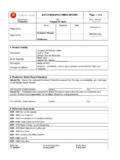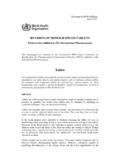Transcription of DATA SHEET PROGYNOVA - Medsafe
1 160419 PROGYNOVA DS 1 data SHEET PROGYNOVA oestradiol valerate tablets Presentation PROGYNOVA 1 mg: The memo-pack holds 28 beige, biconvex, round tablets, each containing mg oestradiol valerate. PROGYNOVA 2 mg: The memo-pack holds 28 light blue, biconvex, round tablets, each containing mg oestradiol valerate. All tablets have a lustrous sugar coating and are approximately 7mm in diameter. Indications Hormone replacement therapy (HRT) for the treatment of signs and symptoms of oestrogen deficiency due to the menopause (whether natural or surgically induced). Prevention of postmenopausal osteoporosis. Dosage and Administration Hormonal contraception should be stopped when HRT is started and the patient should be advised to take non-hormonal contraceptive precautions, if required. Hysterectomised patients may start at any time. If the patient is still menstruating and has an intact uterus, a combination regimen of PROGYNOVA and a progestogen should begin within the first 5 days of menstruation (see below for combination regimen).
2 Patients whose periods are very infrequent or with amenorrhoea or who are postmenopausal may start at any time, provided pregnancy has been excluded. Women changing from other HRT should complete the current cycle of therapy before initiating PROGYNOVA therapy. Continuous Regimen It does not matter at what time of day the patient takes her tablet(s), but once she has selected a particular time, she should keep to it every day. If she forgets to take a tablet at the usual time, she may take it within the following 12 to 24 hours. If the treatment is discontinued for longer, irregular bleeding may occur. One tablet is taken daily (either one beige 1 mg tablet or one blue 2 mg tablet). 160419 PROGYNOVA DS 2 Each pack covers 28 days of treatment. Treatment is continuous, which means that the next pack follows immediately without a break. The tablets are to be swallowed whole with some liquid.
3 Combination Regimen In women with an intact uterus, the concomitant use of an appropriate progestogen is advised for 10 - 14 days every 4 weeks (sequentially combined HRT) or with each tablet of oestrogen (continuous combined HRT). Adequate provision should be made by the physician to facilitate and assure a proper compliance of the patient with the recommended combined regimen. It does not matter at what time of the day the patient takes her tablet, but once she has selected a particular time, she should keep to it every day. If she forgets to take a tablet at the usual time, she may take it within the following 12 to 24 hours. If the treatment is discontinued for longer, irregular bleeding may occur. Contraindications Hormone replacement therapy (HRT) should not be started in the presence of any of the conditions listed below. If any of these conditions appear during use of PROGYNOVA , treatment should be stopped immediately.
4 Pregnancy or lactation Undiagnosed vaginal bleeding Known or suspected cancer of the breast Known or suspected premalignant conditions or malignancies, if sex steroid-influenced Presence or history of liver tumours (benign or malignant) Severe hepatic disease Acute arterial thromboembolism (myocardial infarction, stroke) or a recent history of these conditions Active deep venous thrombosis, thromboembolic disorders, thrombophlebitis, or a documented history of these conditions A high risk of venous or arterial thrombosis Hereditary or acquired predisposition to venous thrombosis ( antithrombin III deficiency) Severe hypertriglyceridamia Hypersensitivity to any of the components of PROGYNOVA 160419 PROGYNOVA DS 3 Warnings and Precautions PROGYNOVA cannot be used as a contraceptive. Before initiating therapy, all conditions/ risk factors mentioned below should be considered when determining the individual benefit/ risk of treatment for the patient.
5 Therapy should be discontinued immediately in case a contraindication is discovered, as well as in the following situations: Migrainous or frequent and unusually severe headaches that occur for the first time or other symptoms that are possible prodroma of cerebrovascular occlusion. Recurrence of cholestatic jaundice or cholestatic pruritus which occurred first during pregnancy or previous use of sex steroids. Symptoms of a thrombotic event or suspicion thereof. In the event of new onset or deterioration of the following conditions or risk factors, the individual benefit/ risk analysis should be re-done, taking into consideration the possible necessity of discontinuing therapy. The potential for an increased synergistic risk of thrombosis should be considered in women who possess a combination of risk factors or exhibit a greater severity of an individual risk factor.
6 This increased risk may be greater than a simple cumulative risk of the factors. HRT should not be prescribed in case of a negative risk benefit assessment. If contraception is required, non-hormonal methods should be used (with the exception of the rhythm and temperature methods). If there is a chance that pregnancy has occurred, tablet taking must be interrupted until it has been ruled out. Oestrogens with or without progestogens should not be used for the long-term maintenance of general health, including the primary prevention of cardiovascular disease as the risks of long-term treatment with HRT in most circumstances, outweigh the benefits. The Women s Health Initiative (WHI) reported increased risks of myocardial infarction, stroke, invasive breast cancer, pulmonary emboli and deep vein thrombosis in postmenopausal women during five years of treatment with conjugated equine oestrogens ( mg) combined with medroxyprogesterone acetate ( mg) relative to the placebo (see table below).
7 The WHI study was designed to investigate the efficacy and safety of long-term HRT in preventing coronary heart disease in healthy postmenopausal with an intact uterus. A total of 8506 women received HRT and 8102 women received placebo for an average of years. 160419 PROGYNOVA DS 4 Table: Summary of the incidence of adverse events described in the WHI study Adverse Event Relative Risk of HRT vs placebo at years (95% CI) Change in number of adverse events per 10,000 women in one year Breast cancer ( ) 8 extra Heart disease ( ) 7 extra Stroke ( ) 8 extra Pulmonary embolism ( ) 8 extra Myocardial infarction ( ) * Deep vein thrombosis ( ) * Colorectal cancer ( ) 6 fewer Hip fracture ( ) 5 fewer * Information not available Other doses of conjugated oestrogens and medroxyprogesterone acetate and other combinations of oestrogens and progestogens were not studied in the Women s Health Initiative (WHI) and, in the absence of comparable data , these risks should be assumed to be similar.
8 Because of these risks, oestrogens and progestogens should be prescribed at the lowest effective doses and for the shortest duration (generally not longer than 3-4 years), consistent with the treatment goals and risks for the individual woman. All prospective and current users of HRT should be advised of the risks and benefits of oestrogens and progestogens and the need for treatment with HRT should be reviewed on a yearly basis. If any of the conditions/risk factors mentioned below is present or deteriorates, an individual risk-benefit analysis should be done before PROGYNOVA is started or continued. Venous Thromboembolism Both randomised-controlled and epidemiological studies have suggested an association between the use of HRT and an increased relative risk (RR) of venous thromboembolism (VTE), deep venous thrombosis or pulmonary embolism. PROGYNOVA is contraindicated in women with a history of or predisposition to thromboembolic disorders.
9 Treatment should be stopped at once if there are symptoms of a thrombotic event or suspicion thereof. Symptoms of venous or arterial thrombosis can include: unilateral leg pain and/or swelling; sudden severe pain in the chest, whether or not it radiates to the left arm; sudden breathlessness; sudden onset of coughing; any unusual, severe, prolonged headache; sudden partial or complete loss of vision; diplopia; slurred speech or aphasia; vertigo; collapse with or without focal seizure; weakness or very 160419 PROGYNOVA DS 5 marked numbness suddenly affecting one side or one part of the body; motor disturbances; acute abdomen. Generally recognised risk factors for VTE include a personal history, a family history (the occurrence of VTE in a direct relative at a relatively early age may indicate genetic disposition), and obesity (body mass index >30 kg/m2). The risk of VTE also increases with age.
10 Extensive varicose veins and superficial thrombophlebitis may have a role in VTE. The risk of VTE may be temporarily increased with prolonged immobilisation, major elective or post-traumatic surgery, or major trauma. Depending on the nature of the event and the duration of the immobilisation, consideration should be given to a temporary discontinuation of HRT. Arterial Thromboembolism Two large clinical trials with continuous combined conjugated oestrogens (CEE) and medroxyprogesterone acetate (MPA) showed a possible increased risk of coronary heart disease (CHD) in the first year of use and no benefit thereafter. One large clinical trial with CEE alone showed a potential reduction of CHD rates in women aged 50-59 and no overall benefit in the total study population. As a secondary outcome, in two large clinical trials with CEE alone or combined with MPA a 30-40% increased risk of stroke was found.
















